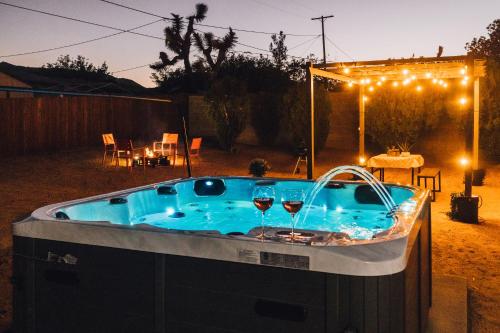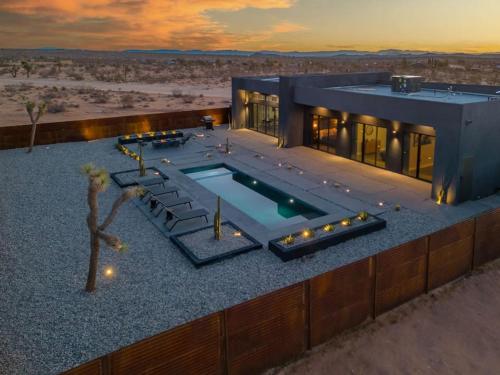Noah Purifoy spent most of his adult life in Los Angeles. It wasn’t until he was 72 that he made the move to Joshua Tree.
The harsh desert – burning and freezing in the same day with dust storms that could scratch your eyes out – didn’t draw him out of the city for any romantic reasons. He came because he couldn’t afford to live in LA anymore.
One of the most interesting artists in America in the 20th century was basically thrown out on the junk heap.
Noah Purifoy may not have seen it this way, but I think there is something befitting about his predicament.
He will be best remembered as an artist who took abandoned pieces of junk and turned them into thoughtful masterpieces. And it turned out that here in the desert, where he was abandoned, he created his greatest collection of all.
It is called the Noah Purifoy Desert Art Museum and it is the result of 15 years of work. The last 15 years of his work, as it happens.
I have included a visit to the Noah Purifoy Desert Art Museum in this Joshua Tree itinerary, which covers the best of the national park.
For the final five years, before he died in 2004, Noah directed helpers from his wheelchair to create his final pieces. But he never stopped.
He wanted to create a legacy that would live on beyond him and continue to inspire and influence. It has worked, as I discover when I visit.
The museum is just on the edge of Joshua Tree National Park in southern California, about two hours drive east of Los Angeles. You can easily pop in and visit it on a trip to the national park, which is what I suspect most people do.
Purifoy always had trouble creating mass appeal or commercial success from his art and that, sadly, has not changed. He is no Van Gogh, who found fame posthumously. It is rare that people make a trip specifically to see this collection of desert art.
For the visitors who do make it here, though, they find a striking world of natural desolation interrupted by human luxuries that have been reimagined into unnatural productions.
The items within each artwork are familiar but the combinations and the placements seem bizarre. They look like houses or playgrounds or civic services… but seem unapproachable.
These creations force us to consider why we would be wary of differences in our perceptions.
It’s a large site and stretches out over about four hectares. There are more than 100 pieces of art here – some of them enormous constructions. It can actually take quite a while to walk around and see each one of them.
I find a strange thing happens during my visit: At first, I see the site as a singular piece of art – a town in the desert. As I walk through, I start to look at each creation individually and interact with it alone, losing sight of the broader setting.
And then, when I’ve seen them all, I feel again like the site is a single entity… but less of the town I first imagined, and more of an organism with a single set of roots underground that breaks through the ground and blossoms in multiple seemingly unconnected locations.
But everyone, I’m sure, has a different reaction at the Noah Purifoy Desert Art Museum. That’s part of the genius of what is happening here.
There are no signs up at each artwork giving you a name or a description – it’s not like a typical museum in that sense. There is no explanation of who the artist is or why he came here.
In fact, there’s nobody here today but me. You can just walk in (there are no fences) for free (there is no ticket booth) and spend as long as you want.
It’s only after my time at the museum that I jump online and do a bit of research in Noah Purifoy as a man and an artist. His story is fascinating.
African American and born in 1917 into a family of 13 children in rural Alabama, you would not be surprised to hear that his professional career touched on the issue of race in the United States.
His most famous work called ’66 Signs of Neon’ was a series of 50 pieces made from debris collected after deadly race riots in LA in 1965 (the Watts riots).
But in the subsequent years, Purifoy didn’t make race a dominant theme in his art. It was the artistic idea of assemblage from ’66 Signs of Neon’ that he continued, rather than the overt political messaging in it.
That’s not to say he didn’t care anymore, he certainly did. But he wanted his art to be about a different kind of visceral emotion.
When he was asked in a PBS interview in 2002 about the meaning of his art, he had the following to say:
“What is the minimum that a person could derive from seeing what it is I do?”
“I say, after you have seen the works, go home and do today what you could not do yesterday. And that’s all inspiration is — so, people don’t have to understand the works.”
I’m not sure Purifoy meant it so literally, but I am taking his advice and doing something I could not do before – sharing my photos of his wonderful desert town/organism/legacy.
I hope you enjoy them… and can see them for yourself one day.
Visit the Noah Purifoy Desert Art Museum
It’s very easy to visit the Noah Purifoy Desert Art Museum and you don’t really need to plan much in advance.
There is no entrance fee and it’s open all day long (from sunrise to sunset).
There’s often nobody working on the site and it’s actually quite likely you won’t see anyone else at all. That adds to the experience of discovering these artworks out in the desert (but also brings an expectation that you’ll behave yourself).
Because it’s outdoors, remember to bring sun protection like a hat. I would also suggest bringing some water (even though you’re only a 10-minute drive from town).
About 30 minutes will be enough time to see all of the sculptures in detail – but, of course, you can spend as much or as little time here as you like.
There are no toilets at the museum (other than the old ones used in artworks), so keep that in mind before you visit.
A few other bits of useful visitor information:
- Well-behaved dogs are welcome to visit as long as they are leashed and you pick up after them.
- You’re not allowed to touch or climb on anything – and also, don’t take anything away with you (it would damage the artwork).
- Taking photos and filming is allowed but drones are prohibited.
- Although the ground is relatively flat, most of it is just sand, so it may not be accessible to all people.
If you want, you can also go online and donate to the foundation to support the museum.
Where is the Noah Purifoy Desert Art Museum?
The Noah Purifoy Desert Art Museum is in the small town of Joshua Tree, just to the north of the national park.
The official address is 63030 Blair Lane, Joshua Tree, California, 92252.
You can see it on a map here.
How do you get to the Noah Purifoy Desert Art Museum?
There are no public transport options to get to the Noah Purifoy Desert Art Museum, but rideshares like Uber may be an option.
The best way to reach the outdoor museum is by car. It’s about a 10-minute drive from the centre of Joshua Tree and about 25 minutes from Twentynine Palms.
When is the Noah Purifoy Desert Art Museum open?
The museum is open daily from sunrise to sunset.
What is the Noah Purifoy Desert Art Museum entrance fee?
Admission is free.
You can see more at the museum’s official website.
Of course, the other main attraction nearby is the national park and I’ve put together a two-day Joshua Tree itinerary to see the best of the park (and includes the Noah Purifoy Desert Art Museum).
If you’ve got some spare time, you might also like to see the quirky little sight called The World Famous Crochet Museum; or the odd Krblin Jihn Cabin, which is the ‘house’ of a fictional religious leader (it’s basically part of a global art project).
For something to eat in Joshua Tree (you may want to grab something if you’ve been/will be going to the national park for the day), I would recommend these options:
- Crossroads Cafe: A retro-style cafe with great breakfasts and some good healthy options.
- JT Country Kitchen: A cozy diner-style restaurant with generous portions.
- Joshua Tree Saloon: Burgers and tortillas, with beers on tap and good cocktails.
- Joshua Tree Coffee Company: No surprises, this is one of the best places in town to get a decent coffee.
Whether you’re coming for the national park or for a bit of a getaway in the desert, there’s plenty to do in Joshua Tree itself – and I think the Noah Purifoy Desert Art Museum is one of the most interesting.
THE BEST ACCOMMODATION IN JOSHUA TREE
There are fewer places to stay in Joshua Tree than Twentynine Palms, but there’s still plenty of variety from motels to holiday houses.
MOTEL

With comfortable rooms at a reasonable rate, High Desert Motel is the best value in Joshua Tree.
VILLA

The cozy accommodation at Center Street Villas gives you a bit more space right in the heart of town.
HOUSE

If you’re travelling in a group, the three bedrooms at this holiday home are all pretty cool.
LUXURY

And for a more luxurious home, the modern Black Sky House has an incredible design and private pool.
Looks like quite an interesting place, its always cool to hear of unique attractions
Noah Purifoy sounds like an interesting individual. It’s great to see his work untouched and available to visit. Great pictures!